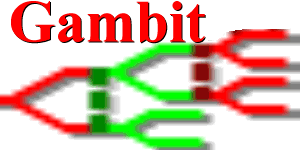Bibliography¶
Articles on computation of Nash equilibria¶
| [Eav71] | B. C. Eaves, “The linear complementarity problem”, 612-634, Management Science , 17, 1971. |
| [GovWil03] | Govindan, Srihari and Robert Wilson. (2003) “A Global Newton Method to Compute Nash Equilibria.” Journal of Economic Theory 110(1): 65-86. |
| [GovWil04] | Govindan, Srihari and Robert Wilson. (2004) “Computing Nash Equilibria by Iterated Polymatrix Approximation.” Journal of Economic Dynamics and Control 28: 1229-1241. |
| [Jiang11] | A. X. Jiang, K. Leyton-Brown, and N. Bhat. (2011) “Action-Graph Games.” Games and Economic Behavior 71(1): 141-173. |
| [KolMegSte94] | Daphne Koller, Nimrod Megiddo, and Bernhard von Stengel (1996). “Efficient computation of equilibria for extensive two-person games.” Games and Economic Behavior 14: 247-259. |
| [LemHow64] | C. E. Lemke and J. T. Howson, “Equilibrium points of bimatrix games”, 413-423, Journal of the Society of Industrial and Applied Mathematics , 12, 1964. |
| [Man64] | O. Mangasarian, “Equilibrium points in bimatrix games”, 778-780, Journal of the Society for Industrial and Applied Mathematics, 12, 1964. |
| [McK91] | Richard McKelvey, A Liapunov function for Nash equilibria, 1991, California Institute of Technology. |
| [McKMcL96] | Richard McKelvey and Andrew McLennan, “Computation of equilibria in finite games”, 87-142, Handbook of Computational Economics , Edited by H. Amman, D. Kendrick, J. Rust, Elsevier, 1996. |
| [PNS04] | Ryan Porter, Eugene Nudelman, and Yoav Shoham. “Simple search methods for finding a Nash equilibrium.” Games and Economic Behavior 664-669, 2004. |
| [Ros71] | J. Rosenmuller, “On a generalization of the Lemke-Howson Algorithm to noncooperative n-person games”, 73-79, SIAM Journal of Applied Mathematics, 21, 1971. |
| [Sha74] | Lloyd Shapley, “A note on the Lemke-Howson algorithm”, 175-189, Mathematical Programming Study , 1, 1974. |
| [Tur05] | Theodore L. Turocy, “A dynamic homotopy interpretation of the logistic quantal response equilibrium correspondence”, 243-263, Games and Economic Behavior, 51, 2005. |
| [Tur10] | Theodore L. Turocy, “Using Quantal Response to Compute Nash and Sequential Equilibria.” Economic Theory 42(1): 255-269, 2010. |
| [VTH87] | G. van der Laan, A. J. J. Talman, and L. van Der Heyden, “Simplicial variable dimension algorithms for solving the nonlinear complementarity problem on a product of unit simplices using a general labelling”, 377-397, Mathematics of Operations Research , 1987. |
| [Wil71] | Robert Wilson, “Computing equilibria of n-person games”, 80-87, SIAM Applied Math, 21, 1971. |
| [Yam93] | Y. Yamamoto, 1993, “A Path-Following Procedure to Find a Proper Equilibrium of Finite Games ”, International Journal of Game Theory . |
General game theory articles and texts¶
| [Harsanyi1967a] | John Harsanyi, “Games of Incomplete Information Played By Bayesian Players I”, 159-182, Management Science , 14, 1967. |
| [Harsanyi1967b] | John Harsanyi, “Games of Incomplete Information Played By Bayesian Players II”, 320-334, Management Science , 14, 1967. |
| [Harsanyi1968] | John Harsanyi, “Games of Incomplete Information Played By Bayesian Players III”, 486-502, Management Science , 14, 1968. |
| [KreWil82] | David Kreps and Robert Wilson, “Sequential Equilibria”, 863-894, Econometrica , 50, 1982. |
| [McKPal95] | Richard McKelvey and Tom Palfrey, “Quantal response equilibria for normal form games”, 6-38, Games and Economic Behavior , 10, 1995. |
| [McKPal98] | Richard McKelvey and Tom Palfrey, “Quantal response equilibria for extensive form games”, 9-41, Experimental Economics , 1, 1998. |
| [Mye78] | Roger Myerson, “Refinements of the Nash equilibrium concept”, 73-80, International Journal of Game Theory , 7, 1978. |
| [Nas50] | John Nash, “Equilibrium points in n-person games”, 48-49, Proceedings of the National Academy of Sciences , 36, 1950. |
| [Sel75] | Reinhard Selten, Reexamination of the perfectness concept for equilibrium points in extensive games , 25-55, International Journal of Game Theory , 4, 1975. |
| [vanD83] | Eric van Damme, 1983, Stability and Perfection of Nash Equilibria , Springer-Verlag, Berlin. |
Textbooks and general reference¶
| [Mye91] | Roger Myerson, 1991, Game Theory : Analysis of Conflict , Harvard University Press. |
